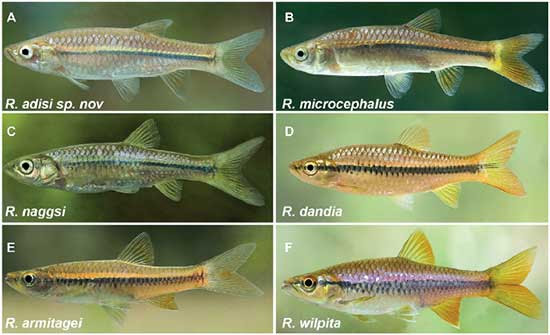Researchers discover new variant of Sri Lankan aquarium fish by Ifham Nizam

Source; Island
A new variant of a popular Sri Lankan aquarium fish has been discovered by local and foreign researchers.
The freshwater fish, genus Rasbora, (commonly called ‘dandiya’) is one of the most diverse groups of freshwater fishes in tropical Asia.
In Sri Lanka, previous studies have shown that there are five species (Rasbora dandia, R. microcephalus, R. wilpita, R. naggsi, and R. armitagei) of which the last three are endemic to the island. This diversity is remarkable when compared with peninsular India, which is about 25 times the size of Sri Lanka but contain only four species of Rasbora.
Biologists earlier believed there were only five varieties of the popular aquarium fish endemic to Sri Lanka. However, with the discovery of the sixth species, Rasbora has gained a new reputation among Sri Lankan freshwater fish breeders, hobbyists and harvesters.
The researchers carried out multiple analysis using “finer geographic sampling and greater sample sizes”, thereby corroborating the validity of six species of Rasbora (scientifically called as ‘Cyprinidae’) in Sri Lanka.
The team of researchers have combed a sampling of 90 sites across Sri Lanka to identify the new species. The team consisting of Hiranya Sudasinghe of Evolutionary Ecology and Systematics Lab, Department of Molecular Biology and Biotechnology, University of Peradeniya, Rohan Pethiyagoda of Ichthyology Section, Australian Museum, Sydney, NSW, Australia, Ranasinghe Hettiarachchige Tharindu Ranasinghe of Butterfly Conservation Society of Sri Lanka, Malwana, Rajeev Raghavan of Department of Fisheries Resource Management, Kerala University of Fisheries and Ocean Studies (KUFOS), Kochi, India, Neelesh Dahanukar of Indian Institute of Science Education and Research (IISER), Pune, India and Madhava Meegaskumbura of Guangxi Key Laboratory of Forest Ecology & Conservation, College of Forestry, Guangxi University, Nanning, China.
Sudasinghe told The Sunday Island that more extensive sampling of Rasbora in India, and analysis based on multiple markers may reveal “a more complex phylogenetic topology” (diversity).
“The Sri Lankan diversification derives from a common ancestor which arrived from India during a sea-level low-stand in the mid-Miocene (15.1 Ma [95% HPD: 11.5–19.8 Ma]), when the present-day island was sub aerially connected to the Indian subcontinent by a broad isthmus”, he added.
Rasbora is generally believed to have arrived in the island from the Indian sub-continent centuries ago when Sri Lanka stood geographically merged with India. In the latest study, researchers confirm this belief.
“Our analysis suggest that Sri Lankan Rasbora derive from a Mid Miocene, India to Sri Lanka dispersal”, he noted, and added that Sri Lankan Rasbora diversity is higher than that of the Indian peninsula.
The Sri Lankan diversity of Rasbora provides an opportunity to understand the evolutionary and phylogenetic relationships of freshwater fishes in the island. Understanding the bio geography, phylogenetic and the evolutionary relationships of species are pivotal in formulating effective assessments of the conservation status of species as well as to draw up species conservation management plans.
However, such studies are still at very early stages when it comes to the freshwater fishes in Sri Lanka.
The first-ever molecular phylogeny of Sri Lankan Rasbora and reassess the taxonomic identities of the five species of Sri Lankan Rasbora based on an island-wide survey. In this study, based on molecular, morphological and statistical analyses using finer geographic sampling, validate the five putative species of Rasbora previously recognized in Sri Lanka.
In addition, a new species of Rasbora was discovered from eastern Sri Lanka. This new species was named Rasbora adisi. The species name “adisi” means mysterious or enigmatic in Sinhala: an allusion to the cryptic nature of this species.
The new species is found in eastern basins in Sri Lanka such as Gal Oya, Menik River and Kumbukkan River and show the closest resemblance to Rasbora naggsi. However, the new species is different from R. naggsi by a combination of morphological characters in addition to been genetically distinct.








No Comments